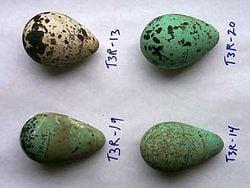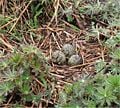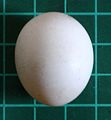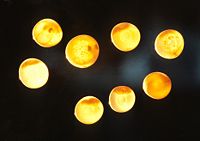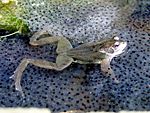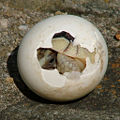Egg (biology)
In most birds and reptiles, an egg (Latin ovum) is the zygote, resulting from fertilization of the ovum. It nourishes and protects the embryo. Oviparous animals are animals that lay eggs, with little or no other development within the mother. The study or collecting of eggs, particularly bird eggs, is called oology.
Reptile eggs, bird eggs, and monotreme eggs, which are laid out of water, are surrounded by a protective shell, either flexible or inflexible.
The 1.5 kg ostrich egg contains the largest existing single cell currently known, though the extinct Aepyornis and some dinosaurs had larger eggs. The Bee Hummingbird produces the smallest known bird egg, which weighs half a gram. The eggs laid by some reptiles and most fish are even smaller, and those of insects and other invertebrates are much smaller still.
Bird eggs
Bird eggs are laid by females and incubated for a time that varies according to the species; a single young hatches from each egg. Average clutch sizes range from one (as in condors) to about 17 (the Grey Partridge). Some birds lay eggs even when not fertilized; it is not uncommon for pet owners to find their lone bird nesting on a clutch of infertile eggs.
Colors
The default color of vertebrate eggs is the white of the calcium carbonate from which the shells are made, but some birds, mainly passerines, produce colored eggs. The pigments biliverdin and its zinc chelate give a green or blue ground color, and protoporphyrin produces reds and browns as a ground color or as spotting.
Non-passerines typically have white eggs, except in some ground-nesting groups such as the Charadriiformes, sandgrouse and nightjars, where camouflage is necessary, and some parasitic cuckoos which have to match the passerine host's egg. Most passerines, in contrast, lay colored eggs, even if there is no need of cryptic colors.
However, a recent study suggests that the protoporphyrin markings on passerine eggs actually act to reduce brittleness by acting as a solid state lubricant. If there is insufficient calcium available in the local soil, the egg shell may be thin, especially in a circle around the broad end. Protoporphyrin speckling compensates for this, and increases inversely to the amount of calcium in the soil.
For the same reason, later eggs in a clutch are more spotted than early ones as the female's store of calcium is depleted.
The color of individual eggs is also genetically influenced, and appears to be inherited through the mother only, suggesting that the gene responsible for pigmentation is on the sex determining W chromosome (female birds are WZ, males ZZ).
It used to be thought that color was applied to the shell immediately before laying, but this research shows that coloration is an integral part of the development of the shell, with the same protein responsible for depositing calcium carbonate, or protoporphyrins when there is a lack of that mineral.
In species such as the Common Guillemot, which nest in large groups, each female's eggs have very different markings, making it easier for females to identify their own eggs on the crowded cliff ledges on which they breed.
Shell
Bird eggshells are diverse. For example:
- cormorant eggs are rough and chalky
- tinamou eggs are shiny
- duck eggs are oily and waterproof
- cassowary eggs are heavily pitted
Tiny pores in bird eggshells allow the embryo to breathe. The domestic hen's egg has around 7500 pores.
Shape
Most bird eggs have an oval shape, with one end rounded and the other more pointy. This shape results from the egg being forced through the oviduct. Muscles contract the oviduct behind the egg, pushing it forward. The egg's wall is still shapeable, and the pointy end develops at the back side. Cliff-nesting birds often have highly conical eggs. They are less likely to roll off, tending instead to roll around in a tight circle, and thus are believed to have been selected for by evolution. In contrast many hole-nesting birds have nearly spherical eggs.
Predation
Many animals feed on eggs. For example, principal predators of the Black Oystercatcher's eggs include raccoons, skunks, mink, river and sea otters, gulls, crows and foxes. The stoat (Mustela erminea) and long-tailed weasel (M. frenata) steal ducks' eggs. Snakes of the genera Dasypeltis and Elachistodon specialize in eating eggs.
Brood parasitism occurs in birds when one species lays its eggs in the nest of another. In some cases, the host's eggs are removed or eaten by the female, or expelled by her chick. Brood parasites include the cowbirds and many Old World cuckoos.
Various bird eggs
Fish eggs

The most common reproductive strategy for fish is known as oviparity, in which the female lays undeveloped eggs that are externally fertilized by a male. Typically large numbers of eggs are laid at one time (an adult female cod can produce 4–6 million eggs in one spawning) and the eggs are then left to develop without parental care. When the larvae hatch from the egg, they often carry the remains of the yolk in a yolk sac which continues to nourish the larvae for a few days as they learn how to swim. Once the yolk is consumed, there is a critical point after which they must learn how to hunt and feed or they will die.
A few fish, notably the rays and most sharks use ovoviviparity in which the eggs are fertilized and develop internally. However the larvae still grow inside the egg consuming the egg's yolk and without any direct nourishment from the mother. The mother then gives birth to relatively mature young. In certain instances, the most physically-developed offspring will devour its smaller siblings for further nutrition while still within the mother's body. This is known as intrauterine cannibalism.
More rarely, some fish such as the hammerhead shark and reef shark are viviparous, with the egg being fertilized and developed internally, but with the mother also providing direct nourishment.
Other eggs
Reptile eggs are often rubbery and are always initially white. Often the sex of the developing embryo is determined by the temperature of the surroundings, with cooler temperatures favouring males. Not all reptiles lay eggs; some are viviparous.
Like fish eggs, amphibian eggs are jellylike and are fertilized externally. They also do not have a shell and therefore need to be laid in water or protective foam as with the Coast foam-nest treefrog, Chiromantis xerampelina.
Other than extinct species, mammal eggs are laid only by Australian monotremes: the platypus and two genera of echidna (spiny anteaters).
A baby tortoise emerges from a reptile egg.
Fish eggs, such as these herring eggs are often transparent and fertilized after laying
ReferencesISBN links support NWE through referral fees
- Marine Biology notes from School of Life Sciences, Napier University.
- Speckles Make Bird Eggs Stronger, Study Finds John Pickrell, National Geographic News, 11 Oct 2005.
- Andrew Gosler, Yet even more ways to dress eggs in British Birds, vol 99 no 7, July 2006
See also
- Chicken sexer
- egg (food)
- Egg yolk
- Egg white
- Trophic egg
- Animal shell
Credits
New World Encyclopedia writers and editors rewrote and completed the Wikipedia article in accordance with New World Encyclopedia standards. This article abides by terms of the Creative Commons CC-by-sa 3.0 License (CC-by-sa), which may be used and disseminated with proper attribution. Credit is due under the terms of this license that can reference both the New World Encyclopedia contributors and the selfless volunteer contributors of the Wikimedia Foundation. To cite this article click here for a list of acceptable citing formats.The history of earlier contributions by wikipedians is accessible to researchers here:
The history of this article since it was imported to New World Encyclopedia:
Note: Some restrictions may apply to use of individual images which are separately licensed.
